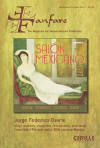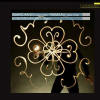Texte paru dans: / Appeared in:

Fanfare Magazine: 36:1(09-10/2012)
Pour
s'abonner / Subscription information
Les abonnés à Fanfare Magazine ont accès aux archives du
magazine sur internet.
Subscribers to Fanfare Magazine have access to the archives of the magazine
on the net.
Ambronay
AMY032

3760135100323
Consultez toutes les évaluations recensées pour ce cd
~~~~ Reach all the evaluations located for this CD
Vivid myths die hard. Palestrina did not save polyphonic music at the Council of Trent. Mozart did not tell Emperor Joseph II that Die Entführung aus dem Serail had just the right number of notes. Louis Marchand did not flee from a contest at organ improvisation with Bach, in Dresden in 1717. Though this was circulated by German nationalist sources for years, late 20th-century scholarship determined that Marchand wasn’t in the German States at the time, and there’s no evidence of such a challenge having been issued, much less accepted. But the truth is often dull, and a good piece of fiction has traction to rival Caterpillar’s.
Though enough background material exists to confirm Marchand’s character as arrogant and impatient, he was regarded in his native France as an organist without peer, praised for his technique and taste. Writer and academician Pierre-Louis d’Aquin de Château-Lyon considered him less artful than Couperin and more natural—in the symbolic language of the times meaning that Marchand’s music was less “infected” with les goûts-réunis and Italianate qualities. Rameau greatly admired him as well. Cuthbert Girdlestone, in his Jean-Philippe Rameau: His Life and Work, was inclined to take seriously a point mentioned in the Mercure de France’s obituary notice, that the composer lived opposite a priory on Paris’s Rue des Cordeliers in his youth primarily for the chance to hear Marchand regularly perform.
Marchand issued two books of harpsichord music: the first in D Minor in 1699, the second in G Minor in 1702. Each consists of only one suite, following Lebègue’s structure of prelude, allemande, courante, sarabande, gigue, then optional pieces (including one powerful chaconne in the first book). Later in life, the composer is known to have written much else that no longer exists—more harpsichord music, organ music, sacred choral works, and at least one opera, Pyrame et Thisbé—but composers of the day distrusted the Parisian publishing industry, which had already become a byword for parsimony, unscrupulous dealings, and editorial carelessness. Many manuscripts weren’t published, and much was lost to time.
Given the quality of the suites, it is to be regretted that Marchand chose not to publish more. They are sui generis, at least where French harpsichord music is concerned. The French, essentially conservative character of the music is never in doubt, but most of the pieces point less to the instrument’s ancestor, the lute, and the style brisé that was then commonly applied, than to the organ loft where Marchand ruled. Independent, simultaneously voiced lines and close, imitative textures abound in many pieces, such as the D-Minor Suite’s gigue, and the free inversion employed in the theme that leads off the second part of that same gigue was to show up as well in several of Bach’s works, such as his French Suites. While Bach could have easily developed this idea on his own, he was a voracious collector and reader of scores, who knew his Vivaldi and Couperin—even engaging in correspondence with the latter (it supposedly ended up being used to line jam-pot lids). Marchand’s busy, relatively heavy-textured harpsichord works might have appealed to Bach on that count alone, leaving aside their elegance and invention.
Christophe Rousset is, as ever, technically adroit and stylistically unapproachable. His generally lively tempos keep the gravitas of these pieces from sinking beneath its own weight, while the subtle use of rubato is never allowed to impede the musical flow. Occasionally he pushes the music uncomfortably, and in one piece goes overboard: the aforementioned D-Minor Chaconne, paced so rapidly as to lose all flexibility of phrasing, and sounding inordinately hectic in a later episode that halves note values; but that is the only movement that stands out forcefully in this fashion. By contrast, the G-Minor Sarabande is given a spacious reading that is consistent with the character of the dance, and emphasizes Marchand’s expressive gifts. I have not heard Davitt Moroney (Plectra 151766) in this music, though I wish Blandine Verlet’s old recording on Astrée E7736 would come back into print, as she’s every bit as good as Rousset throughout, and gets the grandeur of the Chaconne. Ironically, she uses the same instrument as Rousset, a fine Donzelague from 1716, with a focused, bright sound that lacks nothing for sweetness.
There’s much to enjoy here from a musician who clearly loves this music, and the music itself repays close attention.
Cliquez l'un ou l'autre
bouton pour découvrir bien d'autres critiques de CD
Click either button for many other reviews


